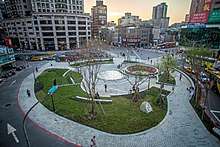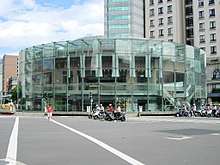Chien-Cheng Circle
The Chien-Cheng Circle (Chinese: 建成圓環; pinyin: Jiànchéng Yuánhuán; Pe̍h-ōe-jī: Kiàn-sêng Îⁿ-khoân) or Taipei Circle (Chinese: 臺北圓環; pinyin: Táiběi Yuánhuán; Pe̍h-ōe-jī: Tâi-pak Îⁿ-khoân), was a bustling food market and a city landmark in Datong District, Taipei, Taiwan. It existed 96 years from its opening during the Japanese colonial era, to its official closing on Sunday, 2 July 2006 after years of decline in resulting from two conflagrations in the 1990s and an unsuccessful project to revitalize the market in 2003. After numerous attempts at re-planning and reopening, the building at the site was eventually demolished in 2016 and a public plaza and park opened in 2017.
| Chien-Cheng Circle | |
|---|---|
| 建成圓環 | |
 | |

| |
| Location | |
| Datong, Taipei, Taiwan | |
| Construction | |
| Type | Roundabout |
| Opened | 1908 (original structure) 2017 (current structure) |
History
The original night market was a circular structure located on a roundabout between Nanjing West Road (南京西路) and Chongqing North Road (重慶北路). It covered an area of 1,722 square meters and dated to the Japanese colonial era.
Beginnings

The circle started out as a fish pond at the intersections of the two roads which the Japanese Government at the planted with trees at the edges and turned into a park. Due to its location, the park attracted a wide variety of cart-based food vendors turning it into the most popular night market in northern Taiwan during the Japanese rule, with the vendors operating well beyond 4am. A bomb shelter was also constructed there during World War II and the pond used as a reservoir for water to put out fires from air raids.[1]
Following the war, the reservoir was drained and vendors began setting up permanently at the park, growing into and organizing the space among themselves organically, eventually converting all the park space into restaurants.[1] The 1960s and 1970s were the heyday of the night market with booths numbering close to 200 and serving Taiwanese snacks and delicacies such as glutinous rice dumplings, oyster omelettes, fish ball noodles, and unfried spring rolls.
Reconstruction
Two fires in 1993 and 1999 contributed to the market's decline, and in March 2001 Taipei Mayor Ma Ying-jeou ordered the demolition of Chien-Cheng Circle. He proposed its reconstruction as part of several projects to revitalize Taipei's older districts. At 10 AM on 29 March 2001, the Chien-Cheng Circle was demolished to make way for its new construction located five meters further south of the original site. The new two-storey cylindrical glass building was designed by Taiwan-based architect C. Y. Lee and cost the Taipei city government NT$160 million in construction fees. An additional NT$50 million in compensation was paid to vendors of the former building. The roundabout was transformed into a crossroad and the surrounding trees were moved to an elementary school in the Xinyi district. During the reconstruction, the engineering team unearthed an old reservoir built by Japanese soldiers during World War II at the center of the circle. The city government decided to make the reservoir the 105th historic spot in Taipei.

The new Chien-Cheng Circle was opened in the evening of 4 October 2003, housing 20 food booths and a performing arts center at the top of the building. To promote the opening, the city government gave away 700 food-tasting coupons worth NT$100 each and organized a tour led by Chuang Yung-ming (莊永明), vice-chairman of the municipal research department and professor at the Taipei Medical University. Although the new building was intended to revitalize the market, food vendors had complained that the modern building did not reflect the market's history and lacked a traditional, cultural feeling. They also said that a lack of promotion and assistance from the city government had hurt business.
Closing
Taipei City Councilwoman Chen Yu-mei held a press conference on Thursday (29 June 2006) to announce the closure and called residents to visit the facility before the official closing on Sunday. The Chien-Cheng Circle had been in decline since its reopening in 2003 and prior to its closing all the stalls on the second floor and five stalls on the first floor had closed with only six stalls on the first floor still in operation. The Taipei City Markets Administration Office in a written statement on 1 July 2006 stated that the renovation project had failed to regain its competitiveness due to the building's design and also problems with vendors. It has given each vendor a sum of NT$800,000 in relocation subsidies.
Planned reopening
In 2008, the Taipei City Government announced that the Chien-Cheng Circle is undergoing a replanning. It was scheduled to reopen in June 2009. However, as of summer 2010 the structure remains derelict and some have postulated the Circle may not return to its former commercial prosperity.[2] In May 2011, the reopening of the Circle was once again postponed due to disputes on lease. Older tenants of the Taipei Circle have blamed the government of the then mayor Ma Ying-jeou for causing the demise of business at the circle.[3]
References
- 韓, 良露 (2014-06-06). 台北回味. 有鹿文化.
- 黃, 忠榮 (2010-04-09), 台北圓環處處破損 議員︰恐成廢墟, 自由電子報 The Liberty Times
- 林, 相美 (2011-05-01), "租約糾紛 建成圓環再熄燈", Liberty Times
- Everington, Keoni. "Taipei Circle being razed to make way for park | Taiwan News". Taipei Circle being razed to make way for park | Taiwan News. Retrieved 2017-11-20.
- 黃, 建豪. "見證西區繁盛興衰 建成圓環今開工拆除 - 政治 - 自由時報電子報". m.ltn.com.tw. Retrieved 2017-11-20.
- 張, 世杰. "有片/建成圓環新生!明晚開放 先睹為快 | 大台北 | 地方 | 聯合新聞網". 聯合新聞網. Archived from the original on 2017-07-19. Retrieved 2017-11-20.
External links
| Wikimedia Commons has media related to Chien Cheng Rotary. |
- Taipei landmark torn down for new plaza The China Post (30 March 2001)
- Landmark food market reopens by Jewel Huang, The Taipei Times (5 October 2003)
- Taipei's oldest night market to close after nearly 100 years United Daily News (30 June 2006)
- Taipei loses appetite for historic Jiancheng market by Mo Yan-chih, Taipei Times (2 July 2006)
- Fond memories of Jiancheng Circle by Mo Yan-chih, Taipei Times (10 July 2006)
- In memory of Chien-Cheng Circle Website created by Taipei City Councilwoman Chen Yu-mei to honor the memory of Chien-Cheng Circle night market.